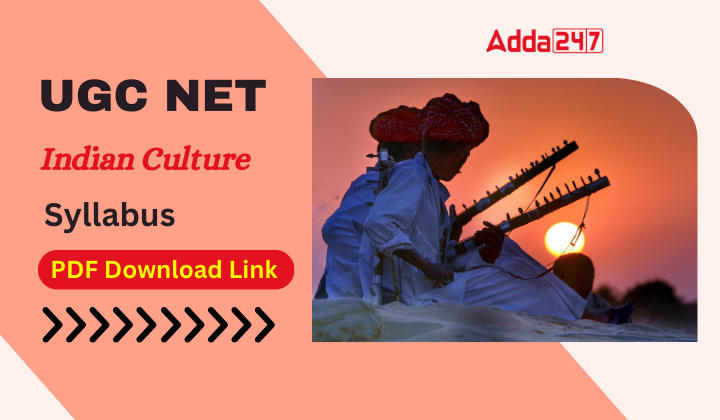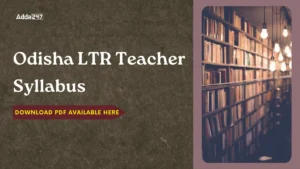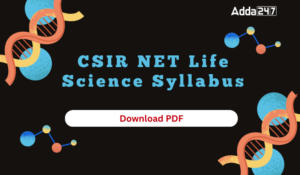Table of Contents
UGC NET Indian Culture syllabus has been released on UGC’s official website. The UGC NET Indian Culture syllabus comprises two papers, addressing teaching and research aptitude in Paper 1, while Paper 2 focuses specifically on Indian Culture. UGC NET Indian Culture syllabus Paper 2 delves into the study of Indian Culture, including prehistoric, protohistoric, and historical periods, covering topics such as human evolution, Stone Age cultures, Harappan civilization, urbanization, excavation techniques, museology, conservation, and recent trends in archaeology. This comprehensive syllabus aims to equip candidates with a deep understanding of archaeological principles, methods, and practices, facilitating their preparation for the UGC NET examination.
UGC NET Indian Culture Syllabus 2025
The UGC NET Indian Culture syllabus encompasses a broad spectrum of topics essential for understanding the discipline, spanning prehistoric, protohistoric, and historical periods. It includes the study of human evolution, Stone Age cultures, the Harappan civilization, urbanization, excavation techniques, museology, conservation, and recent trends in Indian Culture.
Candidates are expected to grasp concepts such as field methods, dating techniques, and cultural heritage preservation, along with an understanding of archaeological ethics and regulations. This comprehensive UGC NET Indian Culture syllabus aims to equip aspiring scholars with the knowledge and skills necessary to navigate the complexities of archaeological research, analysis, and interpretation, fostering a deeper understanding of humanity’s past and its significance in contemporary society.
UGC NET Indian Culture Exam Pattern
UGC NET Syllabus for Indian Culture has been released and available in below article. The UGC NET Indian Culture exam is conducted by the National Testing Agency (NTA) twice a year. It is a computer-based test (CBT) that consists of two papers: Paper 1 and Paper 2.
Paper 1: Teaching and Research Aptitude
- Total Marks: 100
- Total Questions: 50
- Duration: 1 hour (60 minutes)
- Nature of Questions: Objective type, multiple-choice questions
- Topics Covered: Teaching aptitude, research aptitude, reading comprehension, communication, reasoning, logical reasoning, data interpretation, information and communication technology (ICT), and people and environment.
Paper 2: Indian Culture
- Total Marks: 200
- Total Questions: 100
- Duration: 2 hours (120 minutes)
- Nature of Questions: Objective type, multiple-choice questions
- Topics Covered: Meaning and Concepts of Culture, Sources of the Study of Indian Culture, Pre-historic and Proto-historic Cultures, Vedic and Post-Vedic Period, Mauryan and Post-Mauryan Period, Gupta and Post-Gupta period, Early Medieval Period
Sultanate Period, Mughal Period, and Modern Period
UGC NET Indian Culture Paper II Important Topics
The UGC NET Indian CulturePaper II Important Topics are comprehensive and covers various aspects of archaeological study. Here’s UGC NET breakdown of the key areas you’ll encounter:
- Traditional and Modern Concepts of Culture
- Archaeological sources and Cultural remains
- Stone age cultures
- Early Vedic and later Vedic ideas and institutions
- Ashoka’s Dhamma
- Ideas and Institutions of Gupta and Post-Gupta period
- Philosophers- Shankara, Ramanuja emergence of Sultanate school of architecture and paintings, regional styles.
- Zamindari and Zabt
- Impact of Western ideas and Indian responses
UGC NET Indian Culture Syllabus for Paper II
The UGC NET Indian CulturePaper II syllabus covers a wide range of topics related to archaeological theory, methods, and findings, with a particular focus on India. Here’s a breakdown of the key areas:
Unit – I: Meaning and Concepts of Culture
- Traditional and Modern Concepts of Culture
- Notions of Culture in textual tradition, anthropological, archaeological, and sociological understanding
- Elements of Culture
- Concept of Indianness and Value System
- Relation between culture and civilization
- Historiography and approaches to the study of Indian Culture
- Stereotypes, Objectivity, and Bias
- Imperialist, Nationalist, Marxist, and Subaltern perspectives
- Heritage of India and the world’s debt to Indian Culture
Unit – II: Sources of the Study of Indian Culture
- Archaeological sources
- Cultural remains
- Monuments
- Numismatics
- Epigraphy
- Literary Sources and Oral Traditions
- Foreign Accounts
- Archival sources
Unit – III: Pre-historic and Proto-historic Cultures
- Stone age cultures
- Palaeolithic
- Mesolithic
- Neolithic
- Protohistoric cultures
- Chalcolithic horizon
- Harappan Culture
- Current debates on nomenclature and scripts
- Town planning and architecture
- Social, religious, and economic life
- Evolution of India’s main language families
Unit – IV: Vedic and Post-Vedic Period
- Early Vedic and later Vedic ideas and institutions
- Social, religious, economic, political, and scientific
- Post Vedic Religious Movements
- Emergence of states
- Shramana traditions: Buddhism, Jainism, Ajivikas, and other sects
- Education system and centres: Taxila and Kashi
Unit – V: Mauryan and Post-Mauryan Period
- Ideas and Institutions
- Social, Religious, Economic, and Political
- Ashoka’s Dhamma
- Scripts: Brahmi and Kharosthi
- Impact of Foreign Invasions
- Art and Architecture
- Literature
- Scientific Achievements
- Education System and Centres
- Sangam Age: Society and Culture
- Contacts with the outside world
Unit – VI: Gupta and Post-Gupta period
- Ideas and Institutions
- Social, Religious, Philosophical, Economic, and Political
- Scientific Achievements
- Art and Architecture
- Literature
- Canonical Texts
- Education system and centres
- Contacts with outside world
Unit –VII: Early Medieval Period
- Legacies of Classical ideas and the emergence of new trends
- Society- Proliferation of castes, outcastes, Vishti, Slavery. Position of women.
- Polity- feudalism.
- Economy- de-urbanization and agrarian system.
- Religion- Vedic-Puranic, Shramana tradition, Tantra, Bhakti movements.
- Philosophical thoughts- Shaddarshana.
- Philosophers- Shankara, Ramanuja.
- Pilgrimage tradition –
- Art and Architecture- Nagara, Dravida, Bhumija, Vesara.
- Education system and centres- Vikramashila, Nalanda etc.
- Scientific achievements- Mathematics, Astronomy.
- Literature- Kalhana’s Rajatarangini and Al-Birunis’ Kitabul Hind.
- Contacts with Islam
- Canonical texts- – Samaranganasutradhara, Manasara, Bhuvanapradeepa, Sadhanamala.
Unit –VIII: Sultanate Period
- Delhi Sultanate
- Ideas and Institutions
- Political- Iqta; the impact of the new ruling class on society.
- Economic- market reforms, growth of new urban centres, percolation of Islam in rural areas, resistance and acceptance.
- Extent of slavery.
- Religion- Acharya traditions, Bhakti tradition, Kabir and Ravidas, the emergence of Sufism – Chishti and Suhrawardy.
- Art and Architecture- the emergence of Sultanate school of architecture and paintings, regional styles. Religious and secular structures.
- Literature- Sanskrit, Persian, Regional languages and emergence of Hindawi. Amir Khusrau, Chandabardai.
- Education system
- Vijay Nagar Empire
- Ideas and Institutions- political – Nayankara.
- Art and Architecture, Literature, and Educational institutions
Unit – IX: Mughal Period
- Ideas and Institutions
- Polity- Mansab and Jagir, Watan Jagir,
- Economy- Zamindari and Zabt
- Society– Aristocracy, the emergence of middle classes, labourers, Slaves. Position of Women.
- Religion and Philosophy- growth of Vaishnava Bhakti, Panthiesm and Sufi traditions. Sulh-i kul, Naqshabandis. Gurunanaka, Chaitanya Mahaprabhu, Meerabai, Narayanabhatta, Raghunandana.
- Literature development in Sanskrit, Persian and vernacular languagesTulasidasa, Suradasa, Abdur Rahim Khan-i-khanan, Abdul Fazl, Faizi, Badauni, Banarasidas (Ardhakathanaka). Translation of religious texts by Akbar and Dara-Shukoh.
- Art and Architecture- Emergence of Mughal Schools; Temples of Vrindavan– Gobinda Deva and Keshava Das Temple; Four Quarter Gardens.
- Introduction of new education curriculum from Akbar’s period onwards Dars-inizami.
- Religious syncretism in coinage, miniatures and structures.
- Science and Technology – Introduction of mechanical devices, pindrum gearing and astrolabe; Sawai Jai Singh’s observatories.
- Arrival of Europeans and their impact – Portuguese, Spanish, Dutch, English, French.
Unit – X: Modern Period
- Emergence of successor states and cultural developments- Awadh, Hyderabad, Mysore, Marathas and Rajputana.
- Impact of Western ideas and Indian responses- European studies of India; William Jones and Asiatic Society; Fort William College; influence of Christian
- Emergence and Development of New Education System
- Indian Cultural Renaissance
- Socio-Religious reform movements
- Administrative Measures- Brahama Samaja, Aligarh Movement, Ramakrishna Mission and Theosophical Society; Revivalist- Wahabi
and Arya Samaj Movement. Dalit Movements; Sikh reform movements. - Literature- the emergence of Shahr Ashob; Urdu– Mirza Ghalib, Allama Iqbal; Hindi- Bhartendu Harishchand, Prem Chand; Bengali-Bankim Chandra Chatterjee, Rabindranath Tagore, Qazi Nazrul Islam.
- Science and Technology- emergence of modern science and technology
Download UGC NET Indian Culture Syllabus PDF
The direct link to download the UGC NET Indian Culture Syllabus has been provided below. Click on the below link to download the UGC NET Indian Culture Syllabus in Hindi and English.
| Download NET Indian Culture Syllabus PDF in Hindi and English | |
| Language | Download PDF |
| English | Download PDF |
| Hindi | Download PDF |
UGC NET Indian Culture Paper II Marking scheme
The UGC NET Indian Culture Paper II follows a specific marking scheme. UGC NET marking scheme implies that each correct answer earns the candidate 2 marks, and there is no penalty for wrong answers. Therefore, candidates are encouraged to attempt all questions without fear of losing marks for incorrect responses.
- Total Marks: 200
- Total Questions: 100
- Each question carries: 2 marks
- Negative marking: There is no negative marking for incorrect answers.
UGC NET Minimum Indian Culture Paper-II Qualifying marks
The minimum qualifying marks for UGC NET Indian Culture Paper II (and Paper I) depend on your category. The minimum qualifying marks for UGC NET Indian Culture Paper-II are determined based on several factors, including the difficulty level of the examination, the number of candidates appearing for the exam, and the overall performance of candidates.
- General Category (Unreserved): 40% (which translates to 40 marks out of 100 for Paper II).
- OBC Non-creamy Layer, PWD/SC/ST and Transgenders: 35% (which translates to 35 marks out of 100 for Paper II).
Uses of UGC NET Indian Culture Paper II Syllabus
The UGC NET Indian Culture Paper II syllabus serves several important purposes for candidates preparing for the examination:
- Understanding the Exam Scope: By delineating the topics to be encompassed, the syllabus aids candidates in comprehending the breadth and depth of the subject matter requisite for the examination. It furnishes them with a lucid comprehension of the anticipated content of the exam.
- Guidance for Preparation: The syllabus furnishes a systematic framework of the topics candidates must cover during exam preparation. This assists them in arranging their study materials and concentrating on the pivotal areas of the subject.
- Targeted Study: Candidates can utilize the syllabus to discern their proficiencies and deficiencies across various topics. This empowers them to prioritize their study endeavours and allocate additional time to areas necessitating enhancement.
- Resource Selection: With the syllabus serving as a compass, candidates can opt for apt study materials, textbooks, reference books, and online resources congruent with the exam’s subject matter.
- Practice Planning: Leveraging the syllabus, candidates can craft study schedules and practice regimens. They can apportion specific timeframes for delving into each topic and practising answering questions pertinent to those topics.
- Self-Assessment: The syllabus empowers candidates to periodically gauge their progress. They can assess their comprehension of each topic by subjecting themselves to sample questions or mock tests based on the syllabus.
- Exam Strategy: Informed by the syllabus, candidates can devise efficacious exam strategies. They can concentrate on topics carrying greater weightage, ensure a thorough grasp of fundamental concepts, and hone time management skills to complete the exam within the stipulated timeframe.
| UGC NET Related Articles | |
| UGC NET Notification 2025 | UGC NET Application Form 2025 |
| UGC NET Previous Year Question Paper | |




 Odisha LTR Teacher Mains Syllabus 2025 a...
Odisha LTR Teacher Mains Syllabus 2025 a...
 CSIR NET Chemical Science Syllabus 2025,...
CSIR NET Chemical Science Syllabus 2025,...
 CSIR NET Life Science Syllabus 2025 (Par...
CSIR NET Life Science Syllabus 2025 (Par...




